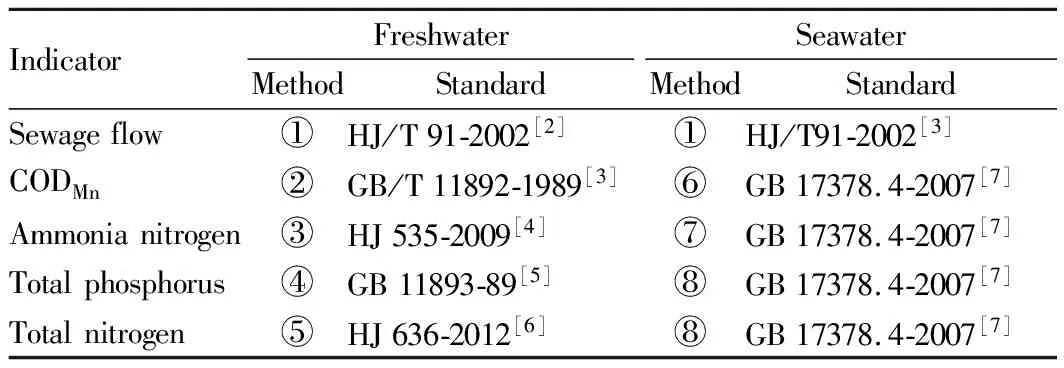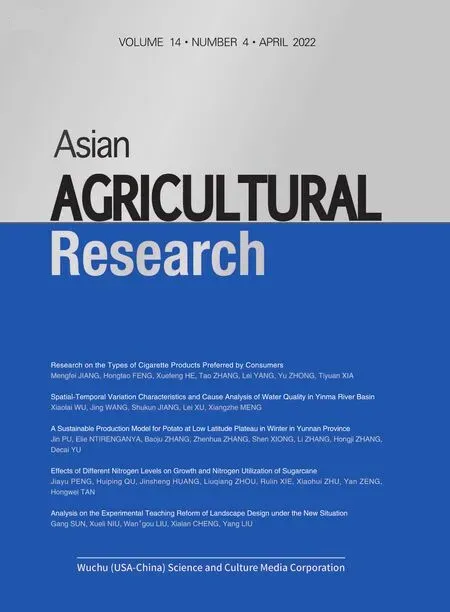Generation and Discharge of Pollutants in Closed Aquaculture
Wansheng SUN, Zhiru FU, Jie YU, Ling ZHANG, Baofeng WANG
Tianjin Agricultural Ecological Environment Monitoring and Agricultural Product Quality Inspection Center, Tianjin 300193, China
Abstract [Objectives]To gain an in-depth understanding of pollutant generation and discharge from closed aquaculture.[Methods]In 2018, the pollutant generation and discharge coefficients of 7 farming modes in 16 farming bases were calculated and analyzed.[Results]A total of 28 pollutant generation coefficients and 28 pollutant discharge coefficients were obtained, and the generation and discharge of pollutants in closed aquaculture were grasped preliminarily.Compared with the data of the first census of pollutions sources published by the state in 2008, 7 kinds of pollution generation coefficients increased, while 14 kinds decreased; and 4 kinds of pollutant discharge coefficients increased, while 17 kinds decreased.[Conclusions]In recent years, the pollutant generation and discharge coefficients of aquaculture show a decreasing trend.
Key words Aquaculture, Self-pollution, Pollutant generation coefficient, Pollutant discharge coefficient
1 Introduction
Aquaculture is an industry that depends on the water environment.In addition to exogenous pollution, the pollution of aquaculture itself will also cause damage to the local water environment.The main sources of impact on the water environment are feed, fertilizer, fish medicine and other inputs and biological waste,etc.With the continuous expansion of the scale of aquaculture in China, the issue of environmental pollution is getting more and more attention.Combining with the aquatic pollution source census project of Tianjin, the generation and discharge coefficients of seven closed aquaculture modes were calculated and analyzed to further explore the pollution generation and discharge status of aquaculture, thereby providing technical reference for quantitative evaluation and calculation of pollution intensity of aquaculture.
2 Materials and methods
2.1 MaterialsIn 2018, 16 farming bases were selected, involving seven farming modes: farmingCyprinuscarpio,Carassiusauratus,PenaeusvannameiandCarassiusauratusLinnaeus in freshwater ponds, farmingTrionyxsinensisin freshwater industrially, farmingP.vannameiin seawater pond, and farmingTakifugurubripesin seawater industrially.In the same production cycle, the water inlets, ponds and outfalls at the 16 monitoring sites were sampled four times, and total 195 samples and 768 monitoring data were obtained.The monitored indicators were total phosphorus, total nitrogen, ammonia nitrogen and chemical oxygen demand(permanganate index).
2.2 Sampling and monitoring methodsSampling and sample fixation were carried out in accordance with theMonitoringProtocolsofFreshwaterFisheryEcologicalEnvironment[1].The monitoring and analysis methods of freshwater and seawater quality are shown in Table 1.

Table 1 Monitoring and analysis methods of freshwater and seawater
2.3 Calculation of pollutant generation and discharge coefficientsThe pollutant generation coefficient refers to the amount of pollutants produced in the water body by producing 1 kg of aquatic products under normal conditions, expressed as g/kg.The sediments are not included.There are great differences in the pollutant generation coefficients of different farming modes.In this study, a total of 7 farming modes were monitored.
The pollutant discharge coefficient refers to the amount of pollutants that are directly discharged into the external water environment such as lake, river and ocean through different channels among the pollutants generated by producing 1 kg of aquatic products under normal conditions, expressed as g/kg.There are great differences in the pollutant discharge coefficients of different farming modes.A total of 7 farming modes were monitored in this study.
The pollutant generation and discharge coefficients were calculated according to the following formulas:

3 Results and analysis
3.1 Calculation results of pollutant generation and discharge coefficientsThe calculation results of the pollutant generation and discharge coefficients are shown in Table 2.

Table 2 Pollutant generation and discharge coefficients g/kg
3.2 Analysis of pollutant generation coefficient(K value)
Among different farming modes, the pollutant generation coefficient of total nitrogen ranked as farmingT.sinensisin freshwater industrially>farmingC.auratusLinnaeus in freshwater pond>farmingC.auratusin freshwater pond>farmingC.carpioin freshwater pond>farmingP.vannameiin freshwater pond>farmingP.vannameiin seawater pond>farmingT.rubripesin seawater industrially.Compared with the data of the first census of pollution sources in 2008 published by the state[8], the total nitrogen generation coefficients increased in four farming modes, farmingP.vannameiin seawater pond, farmingC.auratusin freshwater pond, farmingP.vannameiin freshwater pond and farmingC.auratusLinnaeus in freshwater pond, and decreased in the other three farming modes, farmingT.rubripesin seawater industrially, farmingC.carpioin freshwater pond and farmingT.sinensisin freshwater industrially(Fig.1A).
The total phosphorus generation coefficients of different farming modes were in the following order: farmingT.sinensisin freshwater industrially>farmingT.rubripesin seawater industrially>farmingC.auratusLinnaeus in freshwater pond>farmingP.vannameiin seawater pond>farmingP.vannameiin freshwater pond>farmingC.auratusin freshwater pond>farmingC.carpioin freshwater pond.Compared with the data of the first census of pollution sources in 2008 published by the state, the total phosphorus generation coefficients of farmingP.vannameiin freshwater pond and farmingP.vannameiin seawater pond increased, and those of farmingT.rubripesin seawater industrially, farmingC.auratusin freshwater pond, farmingC.carpioin freshwater pond, farmingC.auratusLinnaeus in freshwater pond and farmingT.sinensisin freshwater industrially decreased(Fig.1B).
The chemical oxygen demand(CODMn)generation coefficients of different farming modes ranked as farmingT.sinensisin freshwater industrially>farmingT.rubripesin seawater industrially>farmingC.auratusLinnaeus in freshwater pond>farmingP.vannameiin seawater pond>farmingP.vannameiin freshwater pond>farmingC.auratusin freshwater pond>farmingC.carpioin freshwater pond.Compared with the data of the first census of pollution sources in 2008 published by the state, the CODMngeneration coefficients of all the farming modes decreased, except that of farmingT.sinensisin freshwater industrially(Fig.1C).

Note: ① Farming Trionyx sinensis in freshwater industrially; ② Farming Carassius auratus Linnaeus in freshwater pond; ③ Farming Cyprinus carpio in freshwater pond; ④ Farming Penaeus vannamei in freshwater pond; ⑤ Farming Carassius auratus in freshwater pond; ⑥ Farming Penaeus vannamei in seawater pond; ⑦ Farming Takifugu rubripes in seawater industrially.The same as below.
The ammonia nitrogen generation coefficients of all the farming modes are in the following order: farmingT.sinensisin freshwater industrially>farmingC.auratusLinnaeus in freshwater pond>farmingP.vannameiin freshwater pond>farmingT.rubripesin seawater industrially>farmingC.auratusin freshwater pond>farmingC.carpioin freshwater pond>farmingP.vannameiin seawater pond.Ammonia nitrogen generation coefficient is not mentioned in the first census of pollution sources in 2008, so no comparison is made.
3.3 Analysis of pollutant discharge coefficient(Z value)
The order of the total nitrogen discharge coefficients of different farming modes was farmingC.auratusLinnaeus in freshwater pond>farmingT.sinensisin freshwater industrially>farmingC.carpioin freshwater pond>farmingC.auratusin freshwater pond>farmingT.rubripesin seawater industrially>farmingP.vannameiin seawater pond>farmingP.vannameiin freshwater pond.Compared with the data of the first census of pollution sources in 2008 published by the state, the total nitrogen discharge coefficients of farmingP.vannameiin seawater pond and farmingC.auratusLinnaeus in freshwater pond increased, and those of farmingT.rubripesin seawater industrially, farmingC.auratusin freshwater pond, farmingP.vannameiin freshwater pond, farmingC.carpioin freshwater pond and farmingT.sinensisin freshwater industrially decreased(Fig.2A).
Among different farming modes, the total phosphorus discharge coefficients ranked as farmingT.rubripesin seawater industrially>farmingT.sinensisin freshwater industrially>farmingP.vannameiin seawater pond>farmingC.carpioin freshwater pond>farmingC.auratusLinnaeus in freshwater pond>farmingC.auratusin freshwater pond>farmingP.vannameiin freshwater pond.Compared with the data of the first census of pollution sources in 2008 published by the state, the total phosphorus discharge coefficient increased in the modes of farmingP.vannameiin seawater pond and farmingP.vannameiin freshwater pond, and decreased in the modes of farmingT.rubripesin seawater industrially, farmingC.auratusin freshwater pond, farmingC.carpioin freshwater pond, farmingC.auratusLinnaeus in freshwater pond and farmingT.sinensisin freshwater industrially(Fig.2B).
The CODMndischarge coefficients of different farming modes were in the following order: farmingT.rubripesin seawater industrially>farmingC.auratusLinnaeus in freshwater pond>farmingT.sinensisin freshwater industrially>farmingP.vannameiin seawater pond>farmingP.vannameiin freshwater pond>farmingC.auratusin freshwater pond>farmingC.carpioin freshwater pond.Compared with the data of the first census of pollution sources in 2008 published by the state, the CODMndischarge coefficients of the seven farming modes all decreased(Fig.2C).

Fig.2 Comparison of total nitrogen,total phosphorus,CODMn discharge coefficients(g/kg)
The ammonia nitrogen discharge coefficients of different farming modes were in the order as farmingC.auratusLinnaeus in freshwater pond>farmingP.vannameiin freshwater pond>farmingT.rubripesin seawater industrially>farmingT.sinensisin freshwater industrially>farmingC.carpioin freshwater pond>farmingC.auratusin freshwater pond>farmingP.vannameiin seawater pond.Ammonia nitrogen discharge coefficient is not mentioned in the first census of pollution sources in 2008, so no comparison is made.
4 Conclusions and recommendations
4.1 ConclusionsIn this study, combined with the actual situation of aquaculture in Tianjin, seven water bodies of closed aquaculture type were selected, and their generation and discharge coefficients of four pollutants, total nitrogen, total phosphorus, ammonia nitrogen and CODMnwere measured and studied.A total of 28 pollutant generation coefficients and 28 pollutant discharge coefficients were obtained.The pollution intensity of the main types of aquaculture in Tianjin has been preliminarily found out, providing technical support for further accounting of pollutant generation and discharge of aquaculture.Compared with the data of the first census of pollution sources in 2008 published by the state, 7 kinds of pollutant generation coefficients increased, while 14 kinds decreased; and 4 kinds of pollutant discharge coefficients increased, while 17 kinds decreased.Overall, the pollutant generation and discharge coefficients showed a decreasing trend.
4.2 RecommendationsThe impact of aquaculture on water bodies depends on the farming mode, species, production and management, and level of wastewater treatment.In order to reduce water pollution and reduce pollutant discharge, attention must be paid to the following issues.First, a reasonable farming capacity should be determined, instead of pursuing high yield blindly.Second, feed should be input reasonably, and the efficiency of feed utilization should be improved.Excessive input of feed is an important factor causing pollution.Third, the treatment of aquaculture waste water should be strengthened.Fourth, new green farming methods should be promoted vigorously to optimize the farming structure, and three-dimensional, ecological and healthy farming modes should be developed to take the road of sustainable development.
 Asian Agricultural Research2022年4期
Asian Agricultural Research2022年4期
- Asian Agricultural Research的其它文章
- A Sustainable Production Model for Potato at Low Latitude Plateau in Winter in Yunnan Province
- Occurrence and Damage and Pathogene of Potato Early Blight in Winter in Yunnan Province, China
- Chromatograph Skeleton Components of Feng-flavor Baijiu during Different Production Stages
- Analysis and Strategy Research on the Mathematics Learning Situation of the Postgraduate Candidates
- Application of ETA in the Management of Mental Health Education for College Students
- Research on the Types of Cigarette Products Preferred by Consumers
